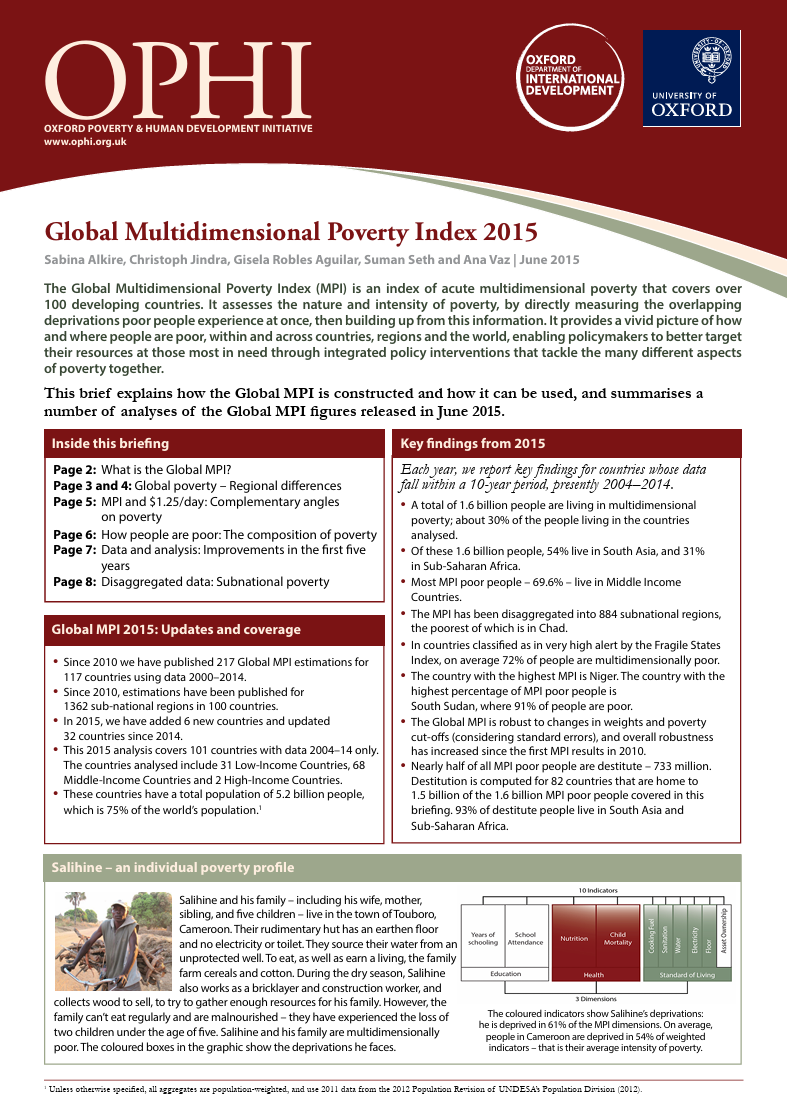Global MPI 2015
The Global MPI 2015 covers 101 countries, which are home to 5.2 billion people using 2011 population data (UNDESA 2012). In 2015, a total of 1.6 billion people are living in multidimensional poverty; roughly 30% of all people living in the countries covered. Across all of the countries measured, the least poor country is Belarus, and the poorest overall is Niger.
Our briefings
The following briefings were published in June:
- Alkire, S., Jindra, C., Robles Aguilar, G., Seth, S. and Vaz, A. (2015). ‘Global Multidimensional Poverty Index 2015’, OPHI Briefing 33, Oxford Poverty and Human Development Initiative (OPHI), University of Oxford. (8 pages)
- Alkire, S., Jindra, C. and Robles Aguilar, G. (2015). ‘Global Multidimensional Poverty Index 2015’, OPHI Briefing 32, Oxford Poverty and Human Development Initiative (OPHI), University of Oxford. (2 pages)
- Alkire, S., Conconi, A., Robles, G. and Vaz, A. (2015). ‘Destitution: Who and where are the poorest of the poor?’, OPHI Briefing 35, Oxford Poverty and Human Development Initiative (OPHI), University of Oxford.
- Alkire, S. and Shen, Y. (2015). ‘Exploring Multidimensional Poverty in China’, OPHI Briefing 34, Oxford Poverty and Human Development Initiative (OPHI), University of Oxford.
In Winter, OPHI published:
- Alkire, S. and Robles, G. (2015). ‘Poverty maps: Mapping Multidimensional Poverty so policies can fight it efficiently’, OPHI Briefing 37, Oxford Poverty and Human Development Initiative (OPHI), University of Oxford.
Our data
The global MPI results are presented in the following Data Tables.
- Data Tables 1.1-2.3
Main MPI results, headcount ratio by dimensions, contribution of deprivations and other measures of poverty and wellbeing at the national level (101 countries) - Data Tables 3.1-4.3
Multidimensional poverty, headcount ratio by dimension and contribution of deprivations in rural and urban areas (99 countries) - Data Tables 5.1-5.4
Multidimensional poverty, headcount ratio by dimension and contribution of deprivations at the sub-national level (884 regions of 77 countries) - Data Tables 6.1-6.6
Changes to MPI poverty over time, including annualised changes in headcount ratio and intensity, changes in each indicator at the national level and changes in destitution where available (34 countries) - Data Table 7
The table presents an archive of all MPI estimations published since 2010. These are not harmonized for comparisons over time (for harmonized estimations see Table 6). Table 7 covers 217 estimations for 117 countries in 2015.
Our Country Briefings
The global MPI Country Briefings present the country-specific results for the countries in this year’s global MPI. In 2015, we published Country Briefings in June and December.



